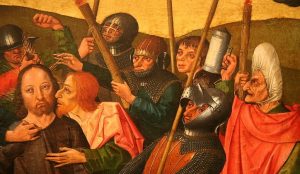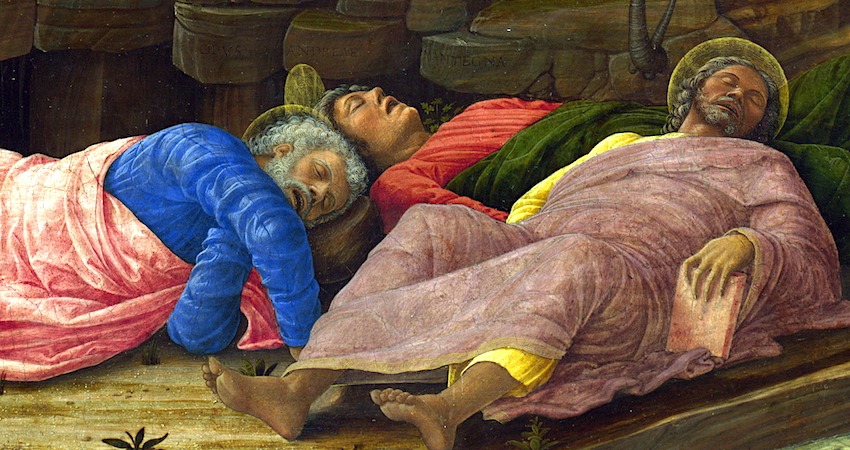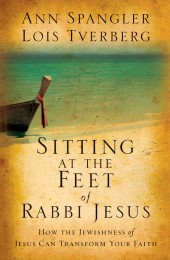About 20 years ago I helped lead a Passover Seder at my church before the congregation gathered for a Maundy Thursday service. Acting out the events of Christ’s last fateful evening led to an experience caused me to rethink how I read the story of Christ’s arrest and death. I wrote about this in Sitting at the Feet of Rabbi Jesus. See below.
~~~~~
The full moon of Passover stared down at Jesus, its light filtering through the shivering leaves of the olive trees, their branches trembling in the early April breeze. Despite the evening chill, sweat glistened on his forehead. Still praying, he stood and then peered into the darkness, listening to a distant murmur of voices. One of his own talmidim, Judas, was approaching. Trailing him was a mob of soldiers, snaking up the hill.
Under a nearby tree, Peter, James, and John were lying in a heap. Twice, Jesus had pleaded with them to stay awake, asking them to keep vigil with him on this, the most difficult night of his life. Yet there they were, wrapped in their heavy woolen talits, mouths agape and snoring softly, oblivious of the approaching threat…
Whenever I think back to this scene from Gethsemane, I can’t help but wonder about Jesus’ narcoleptic disciples. How could they have fallen asleep when their beloved rabbi had implored them to stay awake and remain alert? How could they have nodded off when the climax of salvation history was about to take place? I couldn’t imagine a satisfactory answer, and this was just one of many questions that filled my head whenever I thought back to that fateful week.

I remembered previous Palm Sunday services I had attended, where only minutes after the children stream down the aisles, joyously waving palm branches to celebrate Jesus’ triumphal entry into Jerusalem, the mood shifts, turning solemn as the gospel account of the passion is read. Why were the crowds in Jerusalem so fickle, adoring Jesus one week and then hating him the next?
And why, I wondered, did Jesus choose a Passover Seder to celebrate the last meal of his life?
An Amateurish Passover
Fast forward, now, two thousand years, to the fellowship hall of my church, on the afternoon of the Thursday before Easter, known as Maundy Thursday. We are setting up for a Passover Seder. As Gentile amateurs we are doing our best to recreate the Last Supper, giving ourselves a chance to meditate on its significance. Perfect historical accuracy isn’t the point. Our goal is to relive a little of Jesus’ final evening with his disciples so that we can better appreciate the Maundy Thursday service.
All afternoon the church kitchen bustles with clattering pans and chitchat as we hurry about our tasks, cutting parsley, boiling eggs, and spooning horseradish onto plates. When we finally sit down, I am famished.
 The time ticks by as I endure the long Seder liturgy, with just a bite of parsley dipped in salt water and dry, cardboard-like matzah (unleavened bread) smeared with horseradish to tide me over. When we finally dig into our simple meal of lamb stew, I devour my humble feast! Afterward, I hurriedly help with clean up and then slip into the back of the service, which has already begun. The liturgy is mournful and solemn.
The time ticks by as I endure the long Seder liturgy, with just a bite of parsley dipped in salt water and dry, cardboard-like matzah (unleavened bread) smeared with horseradish to tide me over. When we finally dig into our simple meal of lamb stew, I devour my humble feast! Afterward, I hurriedly help with clean up and then slip into the back of the service, which has already begun. The liturgy is mournful and solemn.
The events of the day have taken their toll on me—the non-stop preparations, beginning the Seder feeling famished, and then overeating to compensate. I feel a crushing lethargy sweep over me. Over the next hour, the sanctuary lights gradually dim to complete darkness. I can barely see through shuttering eyelids. As the service rolls on, I rouse with a start. Did someone call my name? I can almost hear the disappointment in Jesus’ voice. “Could you not watch with me just one hour?”
Suddenly, I understood why the disciples found it so hard to stay awake! And they had an even better excuse than I had. Traditional Passover celebrations involved a huge meal plus four cups of wine, and they started at sunset and went well past midnight. What’s more, they took place after several days of exhausting travel and preparation. Certainly everybody in Jerusalem would have wanted to crawl straight into bed after their late-night feast. Aware of this perennial problem, the rabbis ruled that a person who dozed lightly could remain a part of the dinner, but anyone who fell sound asleep could not.
Our amateurish attempt at reliving the Last Supper led to other insights on the final hours of Jesus’ life. I realized, for instance, why the leaders had plotted to arrest Jesus after the Passover meal. A man so wildly popular couldn’t have been arrested in broad daylight. To avoid an uprising, the chief priests had to proceed in secret. So they let Judas lead them to Jesus while he was outside the city. Passover was the perfect choice, because every Jewish family would be celebrating the feast that started at sundown.
A Trial in the Wee Hours
Jesus’ arrest and trial proceeded swiftly, occurring during the wee hours, when most of his supporters were in bed. Peter’s denials happened as the rooster crowed, around four or five in the morning. According to Mark’s Gospel, Jesus’ final sentence was handed down at sunrise (Mark 15:1). One has to ask, what group of people were around at the crack of dawn on a major Jewish holiday to shout crucify him? Mostly corrupt priests and Roman soldiers who wanted to kill Jesus.
But there’s more. Jesus was crucified at nine in the morning—the time of the first Temple service of the day! The authorities knew they had to finish their secret trial before the crowds re-entered the city. And indeed, as Jesus was carrying his cross out of town, his supporters reappear, weeping out loud as they see him being led to his death (Luke 23:27). His followers had just learned of the events that had transpired the night before.
Prior to our Passover Seder, I had always thought the crowds unimaginably fickle, cheering Jesus one day and then shouting for his head the next. But Jesus’ supporters never changed their minds! How could they have when they were not even present at his arrest or trial? The entire plot unfolded after the Passover festivities, while most people were sound asleep.
 ~~~~~
~~~~~
 The chapter “A Passover Discovery” is from Sitting at the Feet of Rabbi Jesus by Spangler and Tverberg, Zondervan 2009. More info and the option to order available at the link.
The chapter “A Passover Discovery” is from Sitting at the Feet of Rabbi Jesus by Spangler and Tverberg, Zondervan 2009. More info and the option to order available at the link.
You can also download a pdf called “A Taste of Passover” which contains both the chapter excerpt and instructions for celebrating a simple Passover Seder with your family.
Images: John Sillman, Andrea Mantegna

David Sloss says
Lois,
I appreciate so much the view from an Jewish perspective on our faith. Thank you and keep up the good work!
I wonder whether we are correct in calling the supper which Jesus ate with His disciples (what we usually call the Last Supper) the Seder supper of Passover.
Some rationale:
1. Both Matthew’s and Mark’s account seems to have some confusing details claiming it was the “first day of Unleavened Bread” which usually begins the day after Passover. Consequently, how could the Passover meal be prepared if this time had already passed?
2. Luke helps us understand a little better with his stating that the day was the day on which the lambs were sacrificed, namely Nisan 14. (Luke 22:7ff) This suggests that we are prior to the eating of the Passover seder.
3. John gives us some interesting detail which rolls the clock back a bit in chapter 18: “They themselves (religious leaders seeking Jesus’ condemnation) did not enter the governor’s headquarters, so that they would not be defiled, but could eat the Passover.” This is after Jesus’ arrest, after the “Last Supper”, and the religious leaders are careful not to contaminate themselves so that they can eat the Passover, which is still coming!
4. Yes, the Feast of the Passover was at hand, but how can we rationalize the different accounts other than to suggest that the meal which Jesus ate with His talmidim was a meal prior to the Passover seder due to the fact that He, like all the Passover lambs, was slaughtered on the 14th of Nisan and buried late that day, prior to sundown because the Passover was approaching.
5. As I understand, we have in the Passover rituals practiced annually on the Temple Mount for hundreds of years, were rehearsals which were precisely reflected in the death of Jesus – at the same time of day, with the same words, and with the unique aspect of covering the sins of all who would believe.
Blessings on your work and I look forward to your continued writing!
Dr. David Sloss
Lois Tverberg says
Dear Dr. Sloss –
A short answer to your question is that evidence throughout the gospels supports the conclusion that Jesus did celebrate the Passover meal with his disciples. I want to explain more thoroughly with some references. Be looking for a post on that soon.
Lois
Phil says
Also http://doig.net/NTC18.htm brings a little more clarity.
Phil says
Dr. Sloss,
You are probably aware of this gentleman’s work already, but here are some possible theories that may resolve this:
http://doig.net/NTC21.htm
Shalom
Jerry Christensen says
I’m very pleased to have found this site. While not a seminary trained Bible scholar, I have been convicted in recent years to attempt to extract the Jewish Jesus from my westernized christian cultural perspective. I recently have been attending a Jewish discussion group at a nearby synagogue (I’m the only gentile there) studying small villages in Israel with more than the last 2000 years continuous Jewish presence. While discussing Biriya and Zefat, it was mentioned that some Kabbalists (who I’m making no attempt to connect Jesus with) traditionally go out into the olive groves to “sing in” shabbat. I immediately was reminded of the Matthew 26:30 and Mark 14:26 passages. Since Pesach would have been considered a holy day (a shabbat but not necessarily the seventh day of the week), it’s interesting to consider where “singing in the sabbath” might have come from.
Lois Tverberg says
My apologies to Dr. Sloss for my delayed reply about your question about whether the Last Supper was a Passover.
I found a superb series of Passover articles that discuss and answer each of your questions at Derek Leman’s blog. The post most pertinent to your question here is at this link:
http://derek4messiah.wordpress.com/2009/03/11/passover-and-the-last-supper-part-3/
Another great resource is Dr. Steve Notley’s article “Jesus and the Essene Passover” at jerusalemperspective.com.
Leman’s article above points out several facts about John’s gospel that make it very unlikely that even he was suggesting that they ate the Last Supper the night before Passover. The other three gospels make it very plain that they ate a Seder meal, like when Jesus said, “I eagerly desire to eat this Passover with you” in Luke 22:15.
Leman also addresses your desire to line up Jesus’ actions to literally fulfill God’s timing. Passover, don’t forget, lasted over the 24 hour period after the Seder meal was eaten. He points out that Jesus died at the time of the national Passover sacrifice in the Temple, the “chagigah.”
It’s important not to override the plain reading of the text to force it to coincide with the way we think prophecy should play out. Now, as I read Jesus’ death as occurring in the wee hours after the Passover meal, I see exactly how it fits into prophecy.
The night of Passover was called “a night of vigil” because their expectation was that God would carry out his final redemption of his people at that time, just as he did when he redeemed Israel from Egypt. That’s why the cup of Elijah is poured, because Elijah would herald the Messiah.
And look what happened – on the first Passover, the Angel of Death redeemed Israel by bringing the death of Egypt’s firstborn sons. On that very same night in the Gospels we see the redemption of all believers because of the death of God’s firstborn son.
E. Ray Bedford says
The author’s answers regarding the timing of the Last Supper can only be explained as an insult to the author of the Gospel according to John. Be that as it may, all of the discussion is blown away by the author with the words, “It is important not to override the plain… …to coincide with the way we think prophecy should play out.” Does this statement mean that the prophecies regarding Jonah are not to be believed? Does it mean that Jesus did not, indeed remain in the grave three days AND three nights as that prophecy declared and as Jesus himself stated?
Me thinks the author bends scripture a little too much to fit Jewish practice to be satisfactory to many of her Evangelical readers.
Adele Wolfaardt says
Thank you for all the wonderful information!
I think it is important to know that in the Hebrew mindset the sequence of how things happened in a narrative format,is not so important, as it would be in the Western mindset.(Difficult for me as a very analitical person to grasp, but still important to remember!!)
Just want to ask:A day starts at sunset. So, does it mean that 14th Nisan start 18h00 that night, in other words, the Wednesday was the 13th, and on 18h00 Wednesday it changed to be the 14th of Nisan ? So it is the Sedar meal,Passover (which was like a Shabbath?)on the 14th,Feast of Unleavened bread the 15th ,which was Friday, Shabbath the 16th, and Jesus rose sometime after 18h00 on that first Sunday ?? And when does the ‘Feast of Firstfruit’ start?
Thank you once again!!
Shalom!
Dr. Michael Wodlinger says
Shalom, Lois. I have been following this discussion, with some interest. Something no one has yet mentioned is the fact there were two (2) Seders; the first, called the Seder Kittan, the Little Seder, was held by rabbis to teach their talmidim, disciples how to conduct their own Seders the following night. For Yeshua, this was a teaching Seder, as He wanted His talmidim to know more about His future and theirs, once He left earth. I do this helps shed some additional light on the issue.
Adonai’s Blessings
Michael
Lois Tverberg says
Thank you for sharing. Do you have a reference from rabbinic literature about a “Seder Kittan”?
It’s traditional nowadays to have two Passover Seder meals on successive nights. But I can’t see how that could have been possible when the Passover was a pilgrim feast, not a family observance. People traveled for days and spent a lot of money to buy a lamb to bring to the Temple. The lambs were sacrificed all together and then roasted for hours for one festive meal. I can imagine that rabbis might study the feast observance beforehand with their disciples, but I can’t see how they could actually celebrate it.